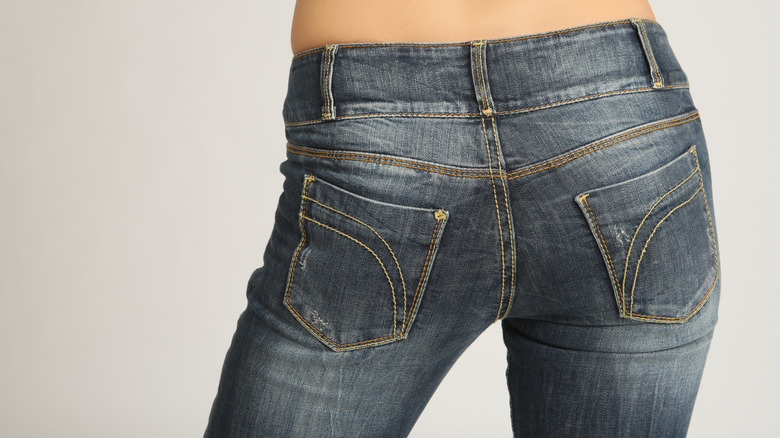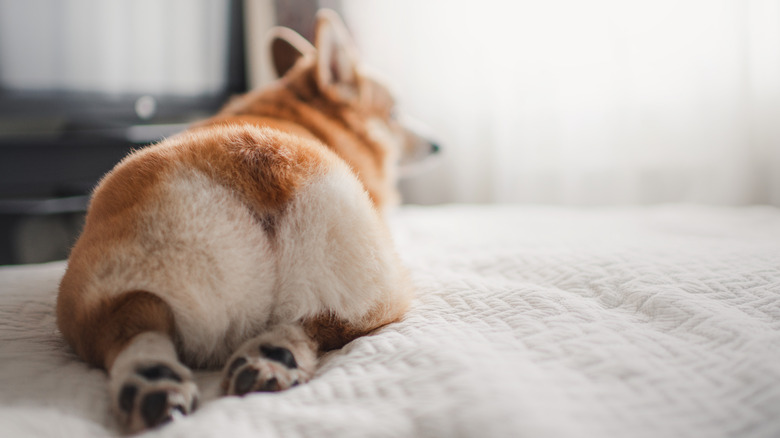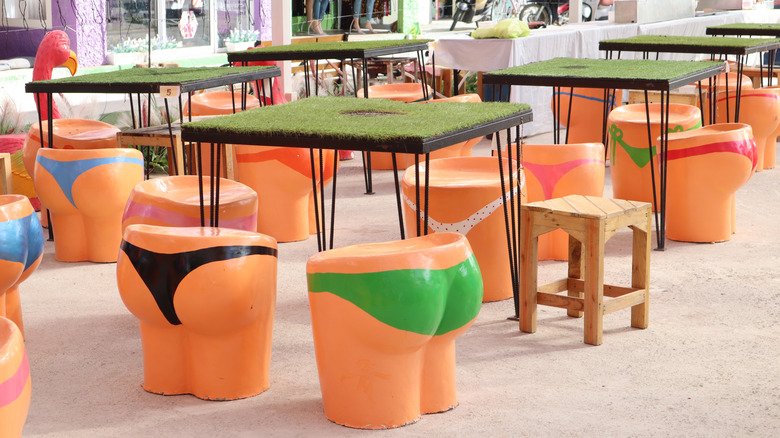Why Do People Have Butts?
Your butt: that thing you sit on all day while mouth-breathing into your phone screen and might never think about except when you've got to try on a new pair of jeans and awkwardly torque your spine to look in a mirror. Yep, that's the subject of today's (cheeky) topic. More specifically: Why do you have one? And aren't you glad you don't have a strong case of baboon butt?
You might think that evolution conspired just to provide us, this one ape race, with the meaty means to tell countless jokes about elevator farting, plumber's crack, and plundered booty. After all, cabooses come in all sorts of fruit-shaped flavors: peach, apple, apricot, plum, perhaps prunes on an off day. But have a look at a chimp's non-existent rear, or a cat's question-marked anus-and-tail. There's just nothing there in terms of derriere.
Some mammals do have lines, slight cracks, or some kind of general fur or muscle enclosure near their anus, like a Corgi, horse, or gorilla. Reptiles, amphibians, insects, fish, or birds, though? No. That's our first clue. Humans share more DNA with mammals like cows (80%) than with fruit flies (60%), as Sciencing reminds us. But what separates us from Corgis, horses, or gorillas? And we don't mean big brains, opposable thumbs, or access to nuclear launch codes. That's right: bipedal locomotion. We walk on two legs and keep our spine upright. This created the hip bones and muscles needed to fashion our unique human posterior, per Massive Science.
In one end and out the other
Before we dive deeper, let's go to the other end of the body: the mouth. Mouths form the first end of the gut, a long tube that travels through the body — throat, esophagus, stomach, small and large intestines — and ends in the anus. End-on-end, the small and large intestines lengthen out to about 15 feet, per Healthline. Their surface area? Half a badminton court.
It's easy to see how important the gut is to life. It allows for ingestion, digestion, and excretion, all rolled into one. In fact, researchers are starting to take another look at the gut, and wonder whether or not our so-called "second brain" isn't actually our "first brain." As Science Focus says, the gut's Enteric Nervous System (ENS) contains trillions of microbes and 50 million to 100 million nerve cells, same as a spinal cord. It operates independently from the Central Nervous System (CNS), but communicates via the vagus nerve, and is related to everything from depression to cancer, Alzheimer's to arthritis.
Guts and digestion evolved way, way before our fancy head brain. But before the anus, the opening of our digestive tube on the other end, digestion was limited. We're talking in and out from one hole, as The Atlantic says. The development of the anus was a marvel of evolution. Creatures could shovel down a new meal while one digested, consume lots more energy than before, and rove in the process.
From four legs to two
Butts more or less surround, or enshroud, the anus, which is helpful for keeping them out of contact with dirty surfaces and for sitting in chairs all day. And some mammals have rears that kinda-sorta look like they're the beginnings of an apple-shape human behind. But not non-mammalian species. Why? Welcome to... Jurassic Park! And Triassic and Cretaceous Parks, during the Mesozoic Era around 245 million to 66 million years ago, per the Natural History Museum. Dinosaurs, similar to Komodo dragons or alligators, had no butts.
The ancestral precursor to mammals first showed up around 300 million years ago. This group of creatures, called synapsids, branched off from amniotes, who had already branched off from tetrapods (the first four-legged creatures). As Field Museum illustrates, one-half of the amniote family swerved towards turtles, crocodiles, lizards, dinosaurs, and finally birds. The other half, synapsids, diverged into mammals, which included marsupials (kangaroos and opossums, among others) and placentals (young carried to term in utero, like bears or humans).
Synapsids came to use gluteal muscles for locomotion, rather than rely on the caudofemoralis muscle of the tail, like dinosaurs, per Gizmodo. Tails became less important, and muscles came to link hips directly to thigh bones. A cat, for instance, uses its tail to balance, but it can still walk without one. It took all the way to about 6 million years ago for the first hominids (human-like species) to tilt their spine vertically, free their front limbs, and start to develop their signature rears.
Gluteal power and pelvic curves
In the end, our twin-cheeked look comes from the pelvis. The shape and tilt of the pelvis effects muscle formation, adipose tissue (fat) storage, and the location of the anus. As Massive Science explains, the three main hip bones, the ilium, ischium, and pubis, fuse during development. But in comparison with other primates, our ilium really stands out. It's short, wide, and curved at the sides, which makes our pelvis kind of bowl-shaped. This allows for greater stability when walking, and ensures that we don't topple over when shifting weight from one leg to the other. In comparison, chimpanzees have taller ilia that are also flat in the front and back. This means they tend to lean forward when they locomote.
Over millions of years, pre-human hips grew squatter and more bowl-shaped, from the 4.4-million-year-old Ardipithecus ramidus, to the well-known Australopithecus afarensis "Lucy," dated back to 3.2 million years ago (per the Smithsonian), all the way to your favorite Saturday cashier at a local Target. Butts are basically big, hefty muscles wrapped in fat. The largest muscle, the gluteus maximus, provides power and shape, while the gluteus medius and minimus offer stability and balance. Butts also provide conveniently located fat storage, which was likely helpful for our ancestors' survival during lean times or when breastfeeding, as Australia's Special Broadcasting Service says.
The only downside? The cheeks make it messier when we poo. But you probably already know this.



